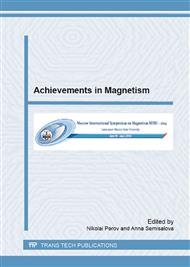[1]
P. Ripka, Magnetic sensors and magnetometers. Artech House Publishers; (2001).
Google Scholar
[2]
L. V. Panina, K. Mohri, K. Bushida, and M. Noda, Giant magnetoimpedance and magnetoinductive effects in amorphous alloys, J. Appl. Phys. 1994. V. 76. 6198.
DOI: 10.1063/1.358310
Google Scholar
[3]
M. Vazquez, J. Magn. Magn. Mater. 2001. Vol. 226 - 230. P. 693 - 699.
Google Scholar
[4]
M. Knobel, K. R. Pirota, J. Magn. Magn. Mater. 2002. Vol. 242 - 245. Pt 1. P. 33 - 40.
Google Scholar
[5]
M. Senda, O. Ishii, Y. Koshimoto, T. Tashima, IEEE Trans. Magn. 1994. Vol. 30. N 6. P. 4611 - 4613.
Google Scholar
[6]
K. Hika, L. V. Panina, K. Mohri, IEEE Trans. Magn. 1996. Vol. 32. N 5. P. 4594 - 4596.
DOI: 10.1109/20.539090
Google Scholar
[7]
T. Morikawa, Y. Nishibe, H. Yamadera et al., IEEE Trans. Magn. 1996. Vol. 32. N 5. P. 4965 - 4967.
Google Scholar
[8]
S. Q. Xiao, Y. H. Liu, S. S. Yan et al., Phys. Rev. B. 2000. Vol. 61. N 8. P. 5734 - 5739.
Google Scholar
[9]
Y. Zhou, J. Xu, X. Zhao, B. Cai, J. Appl. Phys. 2001. Vol. 83. N 3. P. 1816 - 1819.
Google Scholar
[10]
G. V. Kurlyandskaya, J. L. Munoz, J. M. Barandiaran, J. Magn. Magn. Mater. 2002. Vol. 242 - 245. Pt 1. P. 291 - 293.
Google Scholar
[11]
L.V. Panina, K. Mohri, Magneto-Impedance in multilayer Films, Sensors and actuators A, vol. 81, pp.71-77, (2000).
DOI: 10.1016/s0924-4247(99)00089-8
Google Scholar
[12]
D. L. Losee, J. Appl. Phys. 46, 2204 (1975).
Google Scholar
[13]
N. V. Volkov, A. S. Tarasov, E. V. Eremin, S. N. Varnakov, S. G. Ovchinnikov, and S. M. Zharkov, J. Appl. Phys. 109, 123924 (2011).
Google Scholar
[14]
N. V. Volkov, A. S. Tarasov, E. V. Eremin, A. V. Eremin, S. N. Varnakov, and S. G. Ovchinnikov, J. Appl. Phys. 112, 123906 (2012).
DOI: 10.1063/1.4769788
Google Scholar
[15]
N.V. Volkov, A.S. Tarasov, E.V. Eremin, F.A. Baron, S.N. Varnakov, S.G. Ovchinnikov, J. Appl. Phys. 114, 093903 (2013).
Google Scholar
[16]
N. V. Volkov, A. S. Tarasov, D. A. Smolyakov, A. O. Gustaitsev, V. V. Balashev and V. V. Korobtsov, Appl. Phys. Lett. 104, 222406 (2014).
Google Scholar


